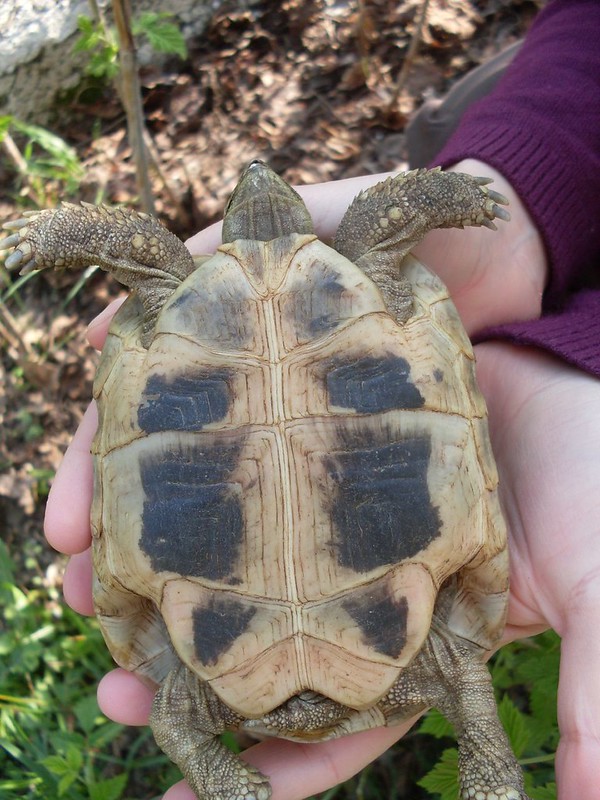One way to tell if your turtle is pregnant is to observe changes in its behavior, such as increased appetite and lethargy. While you can also take your turtle to a veterinarian for an ultrasound, this can be expensive and stressful for the turtle.
Turtles are fascinating creatures that can make great pets. However, caring for a pregnant turtle can be a unique challenge. Unlike other animals, it can be difficult to tell if a turtle is pregnant just by looking at it. However, there are some signs that you can observe to determine if your turtle is pregnant.
In this article, we will explore the behavior changes and physical signs to watch for to determine if your turtle is pregnant. We will also cover some tips and tricks for caring for a pregnant turtle to ensure that she remains healthy and comfortable throughout her pregnancy.

Credit: Redtakesy
Understanding The Life Cycle Of Turtles
Turtles are fascinating creatures that have been around for millions of years. They have a unique life cycle that changes as they mature from hatchlings to adults. As a turtle owner, it is important to understand the different stages of their life cycle.
In this blog post, we will focus on the reproduction cycle of turtles and factors that influence their fertility. So, let’s dive in and learn how to tell if your turtle is pregnant.
Overview Of The Different Stages Of Turtle Life Cycle
Turtles go through several stages of life that include hatchlings, juveniles, and adults. The process may vary depending on the species and environmental factors. Here’s an overview of the different stages of the turtle life cycle:
- Hatchlings: Baby turtles or hatchlings are born from eggs laid in nests on land and emerge from their shells after incubating for 45-90 days. They are tiny and fragile and have a soft, rubbery shell that hardens over time. The hatchlings leave the nest and crawl towards the nearest water source.
- Juveniles: As the hatchlings grow, they become juveniles and start exploring their surroundings. They spend most of their time in the water and feed on algae and small invertebrates. During this stage, their shells harden, and they develop stronger muscles.
- Adults: When turtles reach maturity, they are considered adults. The age of maturity varies between species, but it usually ranges between four to ten years. As adults, they continue to grow, mate and reproduce.
Explanation Of Reproduction Cycle Of Turtles
Turtles reproduce sexually, with the female laying eggs that are fertilized by the male. Mating in turtles can be aggressive, with males fighting over females. However, once a male has successfully mated with a female, the fertilization process begins. Here are the key points to understand about the reproduction cycle of turtles:
- Courtship: Males will often approach females while they are basking in the sun or swimming. They will touch the female’s face and eyes with their snouts and try to mount her.
- Copulation: Mating in turtles can take several hours and can be rough and aggressive. The male will grab onto the female’s shell with his claws and bite her neck, while the female tries to escape.
- Oviposition: After mating, the female will find a suitable nesting site and lay her eggs. Depending on the species, turtles can lay between 10 to 100 eggs in a single clutch. The eggs are buried in sand or soil and left to incubate for several weeks.
Factors That Influence Turtle Fertility
Many factors can influence a turtle’s fertility, including age, health, diet, and environmental conditions. Here are the key points to understand about the factors that influence turtle fertility:
- Age: As with most animals, a turtle’s fertility decreases with age. Younger turtles have a better chance of reproducing successfully.
- Health: Turtles that are healthy and well-fed are more likely to reproduce than those that are sick or malnourished.
- Diet: A balanced and nutritious diet is essential for a turtle’s overall health and reproductive success. Females require more calcium when laying eggs, which can be obtained through a calcium-rich diet.
- Environmental conditions: The quality of a turtle’s habitat can also affect its fertility. Changes in temperature, water quality, and pollution can all impact a turtle’s reproductive success.
Understanding the life cycle of turtles is crucial for turtle owners. By knowing the different stages of a turtle’s life, the reproduction cycle, and factors that influence their fertility, you’ll be better equipped to identify if your turtle is pregnant and care for it accordingly.
5 Surefire Signs Of Turtle Pregnancy: Learn How To Tell
Sign 1: Changes In Behavior
When a turtle is pregnant, there are noticeable changes in their behavior. It’s important to monitor your turtle’s behavior to determine if it is pregnant. Common behaviors to look for include:
- Excessive basking on the basking dock
- Aggressiveness towards other turtles or animals
- Restlessness and pacing
- Increased digging and tunneling behavior
Sign 2: Changes In Eating Habits
Another sign of turtle pregnancy is changes in the turtle’s eating habits. During pregnancy, turtles will eat more than usual, and their appetite may increase or decrease. Look out for these changes in your turtle’s eating habits:
- Increased appetite or loss of appetite
- Change in the types of food they eat
- Feeding more frequently
Make sure to monitor and track their feeding habits to make sure they are getting enough food and maintaining a balanced diet.
Sign 3: Changes In Physical Appearance
A pregnant turtle’s physical appearance will also change during pregnancy. Their shells may look different, and their body may appear swollen. Look out for these physical alterations:
- Swollen and reddened tail
- Enlarged body and belly
- Soft or flexible shell
- Changes in color or texture of the shell
Sign 4: Nesting
As the due date approaches, the turtle will begin to prepare a nesting site. Nesting behavior is common in most turtles. Signs of nesting include:
- Burrowing behavior
- Digging pits in soil or sand
- Moving substrate or leaves around
By identifying these nesting sites, you can prepare for the egg-laying process and ensure the safety of the eggs.
Sign 5: Laying Eggs
The final sign of turtle pregnancy is the process of laying eggs. This is often the most obvious sign of pregnancy in turtles. Signs include:
- Restlessness and agitation
- Frequently visiting the nesting site
- Abdominal contractions and movements
When you observe these signs, be sure to provide your turtle with a suitable nesting area and monitor the egg-laying process to ensure the health of both the mother and the eggs.
By monitoring for these five specific signs, you can determine if your turtle is pregnant. By providing proper care and a suitable nesting area, you can ensure the health and safety of your turtle and its eggs. Remember to always consult with a veterinarian or a reptile expert for further advice and instructions.
Comparing Turtle Pregnancy With Other Reptiles
Explanation Of Reptile Pregnancy Characteristics
Reptiles are known for their unique reproductive strategies. Here are some characteristics of reptile pregnancy:
- Unlike mammals, most reptiles lay eggs.
- Reptile embryos develop outside the mother’s body, in the eggshell.
- Some reptiles, like snakes and lizards, retain their eggs inside their body until it’s time to lay them.
- In some reptile species, the eggs are fertilized internally, while in others, fertilization is external.
- The gestation period varies greatly between reptile species.
Comparison Between Turtle Pregnancy And Other Reptiles
Although turtle pregnancy is unique, it shares some similarities with other reptiles. Here is how turtle pregnancy compares to other reptiles:
- Like other reptiles, most turtles lay eggs. However, some species of turtles, like the softshell turtle, retain their eggs inside their body until it’s time to lay them.
- Turtles have a longer gestation period compared to other reptiles, which can range from 45 to 200 days depending on the species.
- Unlike many other reptiles, turtle embryos develop a calcareous shell around the egg in the oviduct, which provides extra protection to the developing embryo.
Discussion On What Sets Turtle Pregnancy Apart
Turtle pregnancy is unique in several ways. Here’s what sets turtle pregnancy apart:
- Unlike most reptiles, turtle eggs have a calcified shell that provides exceptional protection for the developing embryo.
- Turtle pregnancy lasts longer than most other reptiles, as it can range from 45 to 200 days.
- Some species of turtles, like the softshell turtle, can retain their eggs inside their body until it’s time to lay them.
- Turtles have a low reproductive rate compared to other reptiles due to the high energy demands of producing eggs and the difficulty of finding suitable nesting sites.
Frequently Asked Questions Of How To Tell If Your Turtle Is Pregnant
How Long Is A Turtle’S Gestation Period?
The gestation period for turtles vary species to species, but it can last anywhere between 45 and 90 days.
Is It Difficult To Tell If A Turtle Is Pregnant?
Yes, it can be challenging to tell if your turtle is pregnant because their gestation period is very short, and they hide their pregnancy symptoms well.
What Are Some Signs That A Turtle Is Pregnant?
Some of the signs of a pregnant turtle include decreased appetite, enlarged size, lethargy, and nesting behavior, such as digging or hiding.
Can A Pregnant Turtle Lay Eggs Without Mating?
Turtles can store sperm for extended periods, and it’s possible for them to lay eggs even if they haven’t mated recently. These eggs will not have viable embryos inside them.
What Should I Do If My Pet Turtle Is Pregnant?
If you think your turtle is pregnant, you should provide a nesting area with soft soil or sand and a heat lamp to maintain the right temperature. Also, give her some privacy and avoid handling her frequently.
Conclusion
After reading this article, you should now have a good understanding of how to tell if your turtle is pregnant. As a responsible pet owner, it’s essential to keep a close eye on your turtle’s behavior, diet, and environment to ensure she stays healthy throughout her pregnancy.
Remember to provide fresh water, a spacious enclosure, and a balanced diet to support your turtle’s health. If you do suspect that your turtle is pregnant, monitor her behavior closely and seek advice from a veterinarian if you have any concerns.
Finally, if you are interested in breeding your turtles, make sure you research thoroughly and have the necessary resources and experience to support a breeding program. With proper care and attention, your turtle could have a safe and successful pregnancy, bringing new life to your home.
Recent Posts
Turtles headbutt black things due to their instinctual response to threats or territorial disputes. When turtles encounter black objects, they may perceive them as intruders or competitors, leading...
To fix a hole in a turtle shell, clean the wound thoroughly and apply adhesive or a patch specifically designed for shell repairs. Then monitor the turtle for any signs of infection or further...

